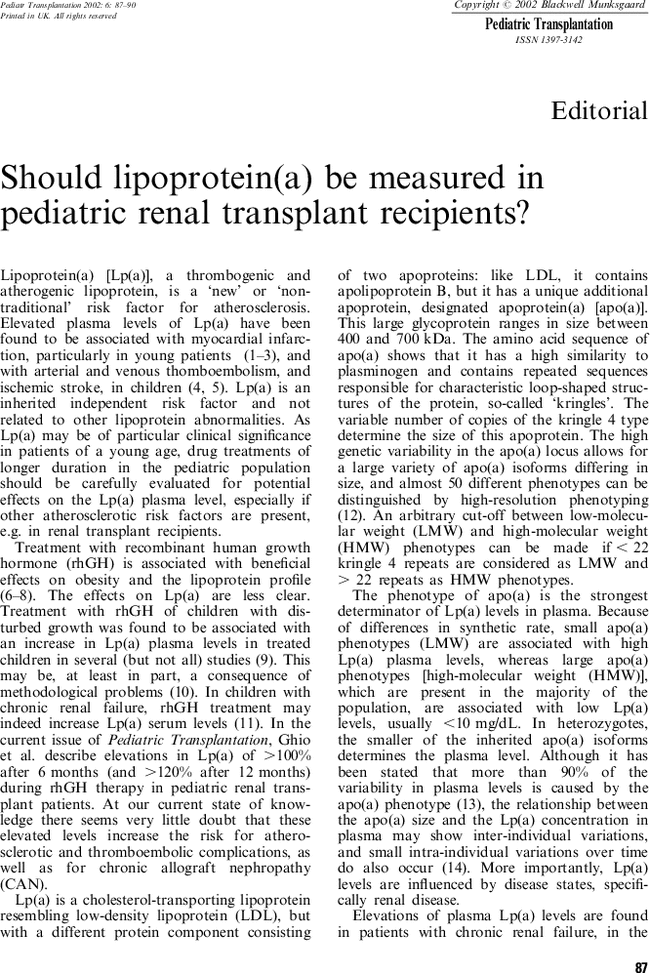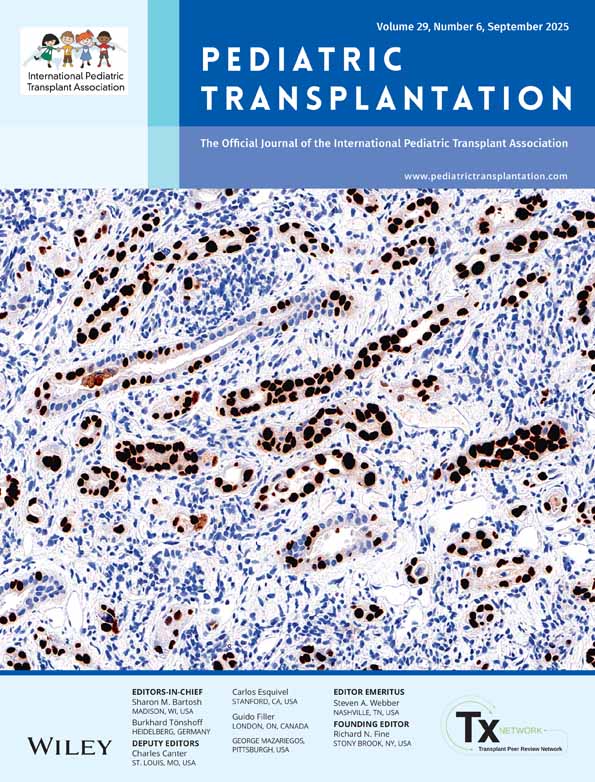Should lipoprotein(a) be measured in pediatric renal transplant recipients?
Uwe Querfeld MD
Department of Pediatric Nephrology, Humboldt University Berlin, Charité Children's Hospital, Schumannstr. 20–21, 10117 Berlin, Germany Tel. 0049-30-4505-16012 Fax: 0049-30-4505-16912 E-mail: [email protected]
Search for more papers by this authorFriederike Wahn MD
Department of Pediatric Nephrology, Humboldt University Berlin, Charité Children's Hospital, Schumannstr. 20–21, 10117 Berlin, Germany Tel. 0049-30-4505-16012 Fax: 0049-30-4505-16912 E-mail: [email protected]
Search for more papers by this authorUwe Querfeld MD
Department of Pediatric Nephrology, Humboldt University Berlin, Charité Children's Hospital, Schumannstr. 20–21, 10117 Berlin, Germany Tel. 0049-30-4505-16012 Fax: 0049-30-4505-16912 E-mail: [email protected]
Search for more papers by this authorFriederike Wahn MD
Department of Pediatric Nephrology, Humboldt University Berlin, Charité Children's Hospital, Schumannstr. 20–21, 10117 Berlin, Germany Tel. 0049-30-4505-16012 Fax: 0049-30-4505-16912 E-mail: [email protected]
Search for more papers by this author
References
- 1 Scanu AM. Lipoprotein(a). A genetic risk factor for premature coronary heart disease. JAMA 1992: 267: 3326–3329.
- 2 Sandkamp M, Funke H, Schulte H, Kohler E, Assmann G. Lipoprotein(a) is an independent risk factor for myo-cardial infarction at a young age. Clin Chem 1990: 36: 20–23.
- 3 Gazzaruso C, Garzaniti A, Buscaglia P, et al. Associa-tion between apolipoprotein(a) phenotypes and coronary heart disease at a young age. J Am Coll Cardiol 1999: 33: 157–163.
- 4 Nowak-Gottl U, Strater R, Heinecke A, et al. Lipo-protein(a) and genetic polymorphisms of clotting factor V, prothrombin, and methylenetetrahydrofolate reductase are risk factors of spontaneous ischemic stroke in childhood. Blood 1999: 94: 3678–3682.
- 5 Nowak-Gottl U, Debus O, Findeisen M, et al. Lipoprotein(a): its role in childhood thromboembolism. Pedi-atrics 1997: 99: E11.
- 6 Wabitsch M, Heinze E. Body fat in GH-deficient children and the effect of treatment. Horm Res 1993: 40: 5–9.
- 7 Rosenbaum M, Gertner JM, Leibel RL. Effects of systemic growth hormone (GH) administration on regional adipose tissue distribution and metabolism in GH-deficient children. J Clin Endocrinol Metab 1989: 69: 1274–1281.
- 8 Querfeld U. Is the impact of recombinant human growth hormone (rhGH) on the plasma lipid profile beneficial or harmful? Br J Clin Pract Suppl 1996: 85: 54–55.
- 9 Querfeld U, Dopper S, Gradehand A, Kiencke P, Wahn F, Ziesel HJ. Long-term treatment with growth hormone has no persisting effect on lipoprotein(a) in patients with Turner's syndrome. J Clin Endocrinol Metab 1999: 84: 967–970.
- 10 Wieringa G, Toogood AA, Ryder WD, Anderson JM, Mackness M, Shalet SM. Changes in lipoprotein(a) levels measured by six kit methods during growth hormone treatment of growth hormone-deficient adults. Growth Horm IGF Res 2000: 10: 14–19.
- 11 Querfeld U, Haffner D, Wuhl E, et al. Treatment with growth hormone increases lipoprotein(a) serum levels in children with chronic renal insufficiency. Eur J Pediatr 1996: 155: 913.DOI: 10.1007/s004310050515
- 12 Marcovina SM, Hobbs HH, Albers JJ. Relation between number of apolipoprotein(a) kringle 4 repeats and mobility of isoforms in agarose gel: basis for a standardized isoform nomenclature. Clin Chem 1996: 42: 436–439.
- 13 Boerwinkle E, Leffert CC, Lin J, Lackner C, Chiesa G, Hobbs HH. Apolipoprotein(a) gene accounts for greater than 90% of the variation in plasma lipoprotein(a) concentrations. J Clin Invest 1992: 90: 52–60.
- 14 Nazir DJ, Mcqueen MJ. Monthly intra-individual variation in lipoprotein(a) in 22 normal subjects over 12 months. Clin Bio-chem 1997: 30: 163–170.
- 15 Kronenberg F, Utermann G, Dieplinger H. Lipoprotein(a) in renal disease. Am J Kidney Dis 1996: 27: 1–25.
- 16 Querfeld U, Lang M, Friedrich JB, Kohl B, Fiehn W, Scharer K. Lipoprotein(a) serum levels and apolipoprotein(a) phenotypes in children with chronic renal disease. Pediatr Res 1993: 34: 772–776.
- 17 Dieplinger H, Lackner C, Kronenberg F, et al. Elevated plasma concentrations of lipoprotein(a) in patients with end-stage renal disease are not related to the size polymorphism of apolipoprotein(a). J Clin Invest 1993: 91: 397–401.
- 18 Kerschdorfer L, Konig P, Neyer U, et al. Lipoprotein(a) plasma concentrations after renal transplantation: a prospective evaluation after 4 years of follow-up. Atheroscler-osis 1999: 144: 381–391.
- 19 Kandoussi AM, Hugue V, Cachera C, et al. Apo(a) phenotypes and Lp(a) concentrations in renal transplant patients. Nephron 1998: 80: 183–187.
- 20 Kronenberg F, Konig P, Lhotta K, et al. Apolipoprotein(a) phenotype-associated decrease in lipoprotein(a) plasma concentrations after renal transplantation. Arterioscler Thromb 1994: 14: 1399–1404.
- 21 Singh A, Stablein D, Tejani A. Risk factors for vascular thrombosis in pediatric renal transplantation: a special report of the North American Pediatric Renal Transplant Cooperative Study. Transplantation 1997: 63: 1263–1267.
- 22 Kasiske BL. Cardiovascular disease after renal transplantation. Semin Nephrol 2000: 20: 176–187.
- 23 Fellstrom B. Impact and management of hyperlipidemia posttransplantation. Transplantation 2000: 70: SS51–SS57.
- 24 Wahn F, Daniel V, Kronenberg F, Opelz G, Michalk DV, Qerfeld U. Impact of apolipoprotein(a) phenotypes on long-term renal transplant survival. J Am Soc Nephrol 2001: 12: 1052–1058.
- 25 Foody JM, Milberg JA, Robinson K, Pearce GL, Jacobsen DW, Sprecher DL. Homocysteine and lipoprotein(a) interact to increase CAD risk in young men and women. Arterioscler Thromb Vasc Biol 2000: 20: 493–499.
- 26 Thillet J, Doucet C, Chapman J, Herbeth B, Cohen D, Faure-Delanef L. Elevated lipoprotein(a) levels and small apo(a) isoforms are compatible with longevity: evidence from a large population of French centenarians. Atherosclerosis 1998: 136: 389–394.
- 27 Simons L, Friedlander Y, Simons J, McCallum J. Lipoprotein(a) is not associated with coronary heart disease in the elderly: cross-sectional data from the Dubbo study. Atherosclerosis 1993: 99: 87–95.
- 28 Yamauchi K, Tanahashi Y, Okada M, et al. Long-term effects of niceritrol on serum lipoprotein(a) and lipids in patients with high levels of lipoprotein(a). Clin Ther 1995: 17: 52–59.
- 29 Carlson LA, Hamsten A, Asplund A. Pronounced lowering of serum levels of lipoprotein Lp(a) in hyperlipidaemic subjects treated with nicotinic acid. J Intern Med 1989: 226: 271–276.
- 30 Nakahama H, Nakanishi T, Uyama O, et al. Niceritrol reduces plasma lipoprotein(a) levels in patients undergoing maintenance hemodialysis. Ren Fail 1993: 15: 189–193.
- 31 Gotto JAJ, Farmer JA. Pleiotropic effects of statins: do they matter? Curr Opin Lipidol 2001: 12: 391–394.
- 32 Bommer C, Werle E, Walter-Sack I, et al. D-thyroxine reduces lipoprotein(a) serum concentration in dialysis patients. J Am Soc Nephrol 1998: 9: 90–96.
- 33 Blacher J, Demuth K, Guerin AP, Safar ME, Moatti N, London GM. Influence of biochemical alterations on arterial stiffness in patients with end-stage renal disease. Arterioscler Thromb Vasc Biol 1998: 18: 535–541.
- 34 Kronenberg F, Kathrein H, Konig P, et al. Apolipoprotein(a) phenotypes predict the risk for carotid ather-osclerosis in patients with end-stage renal disease. Arter-ioscler Thromb 1994: 14: 1405–1411.




